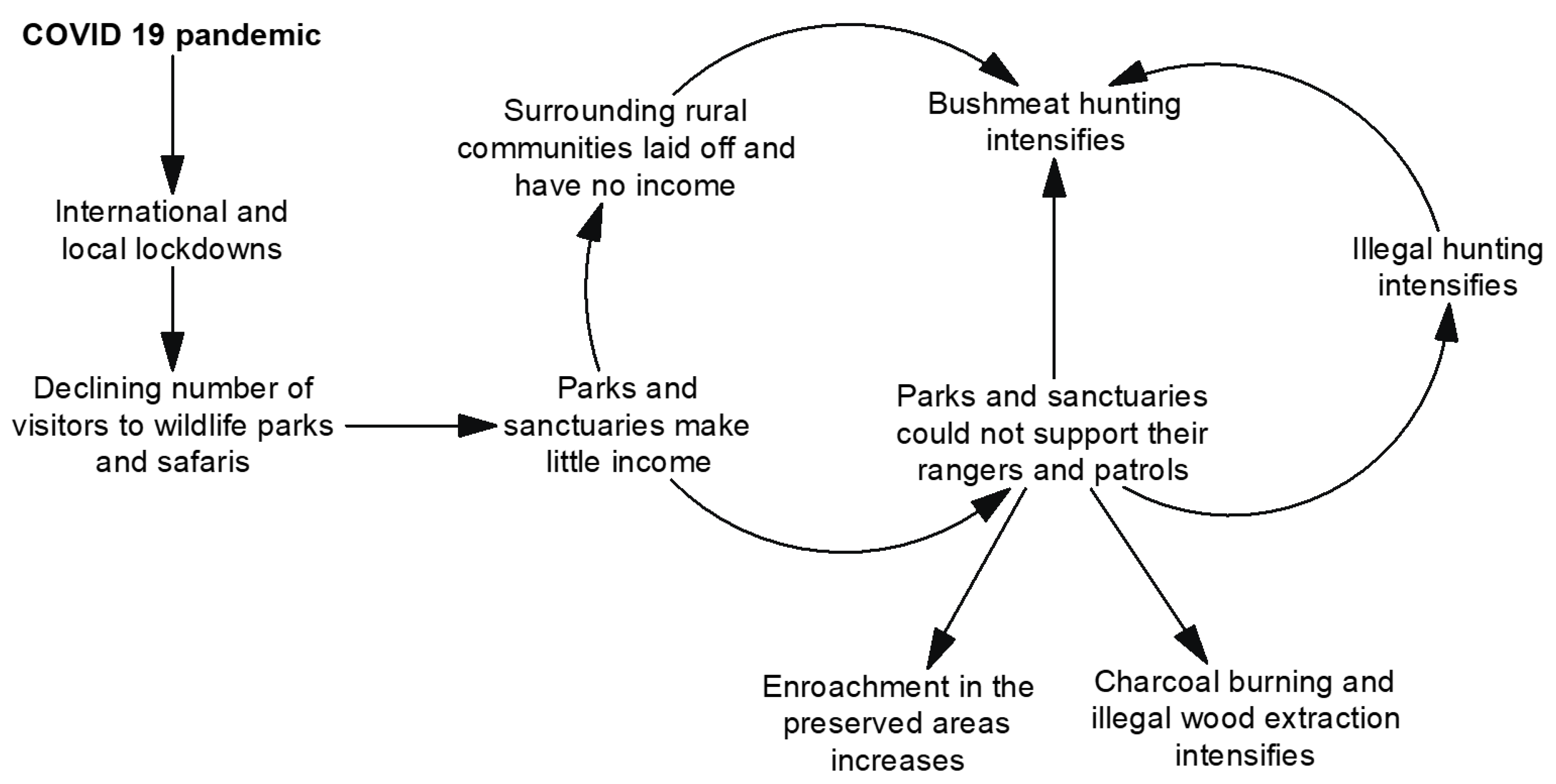COVID-19 Pandemic and Agroecosystem Resilience: Early Insights for Building Better Futures
Abstract
1. Introduction
2. Methods
2.1. Defining the Analytical Scope
2.2. Selection of the Relevant Frameworks
- The adaptive (r-K-Ω-α) cycle introduced by the Resilience Alliance [23] (Figure 2A), accounting for the ‘collapse’ phase (Ω) where existing assets as well as network connectivity are lost, preceding a reorganization phase (α), a rapid growth or pioneer phase (r), and a gradual approach to carrying capacity (K). This framework highlights the processes or phases in which change is happening a given agroecosystem once disruption happen.
- Interacting Driver-Pressure-System(state)-Impacts-Responses (DPSIR) cycles [24], with adaptive, mitigative, transformative, and reimaginative responses, advanced by issue attention cycle that encompasses agenda setting, better understanding, commitment and coalitions for change, devolved details of implementation and evaluation of effectiveness (Figure 2B). DPSIR identifies how a given driver, that causes disruption to the way agroecosystems function, creates pressure and hence influences the system as a whole.
2.3. Literature Search and Data Synthesis Procedures
3. Results and Discussion
3.1. Summary of the Impact Reportings of Effects of the COVID-19 Pandemic on Social–Ecological Systems Attributes
3.2. Collapse Phase and Early Signs of Reorganization
3.2.1. The Pandemic Effects on Communities and Early Responses
3.2.2. Likely Effects of COVID-19 Pandemic on Households and Local Livelihoods Dependent on Agroecosystems
3.2.3. COVID-19 Induced Social Support System Dynamics and the Resulting Pressure on Agroecosystems
3.3. COVID-19 and Its Potential Impacts on Sectors Directly Linked to Agroecosystems
3.3.1. Broader Sector-Level Issues Arising Due to COVID-19 and the Consequences
3.3.2. Disruptions of Interventions and Innovations for Agroecosystems Management
3.3.3. Shrinking Returns and Revenues from Agroecosystem Dependent Sectors
3.3.4. Shrinking Social Capital for Agroecosystem Management
3.3.5. Diversion of Resources away from Agroecosystems to Pandemic Response
4. What Ways Forward?
4.1. Building Better Futures: Broader Response Options at Socioecological Scale
4.2. Mending People–Nature Relations: Management of Socioecological Systems to Build Better Futures
5. Concluding Thoughts
Supplementary Materials
Author Contributions
Funding
Institutional Review Board Statement
Informed Consent Statement
Data Availability Statement
Acknowledgments
Conflicts of Interest
References
- Morse, S.S.; Mazet, J.A.; Woolhouse, M.; Parrish, C.R.; Carroll, D.; Karesh, W.B.; Zambrana-Torrelio, C.; Lipkin, W.I.; Daszak, P. Prediction and prevention of the next pandemic zoonosis. Lancet 2012, 380, 1956–1965. [Google Scholar] [CrossRef]
- Barry, J.M. The next pandemic. World Policy J. 2010, 27, 10–12. [Google Scholar] [CrossRef] [PubMed]
- Mollentze, N.; Streicker, D.G. Viral zoonotic risk is homogenous among taxonomic orders of mammalian and avian reservoir hosts. Proc. Natl. Acad. Sci. USA 2020, 117, 9423–9430. [Google Scholar] [CrossRef] [PubMed]
- Peeri, N.C.; Shrestha, N.; Rahman, M.S.; Zaki, R.; Tan, Z.; Bibi, S.; Baghbanzadeh, M.; Aghamohammadi, N.; Zhang, W.; Haque, U. The SARS, MERS and novel coronavirus (COVID-19) epidemics, the newest and biggest global health threats: What lessons have we learned? Int. J. Epidemiol. 2020. [Google Scholar] [CrossRef]
- De Nicola, G.; Schneble, M.; Kauermann, G.; Berger, U. Regional now-and forecasting for data reported with delay: A case study in COVID-19 infections. arXiv 2020, arXiv:arXiv:2007.16058. [Google Scholar]
- Dessler, A.E.; Parson, E.A. The Science and Politics of Global Climate Change: A Guide to the Debate; Cambridge University Press: Cambridge, UK, 2019. [Google Scholar]
- Van Noordwijk, M. Integrated natural resource management as pathway to poverty reduction: Innovating practices, institutions and policies. Agric. Syst. 2019, 172, 60–71. [Google Scholar] [CrossRef]
- Huang, J.; Liu, X.; Zhang, L.; Yang, K.; Chen, Y.; Huang, Z.; Liu, C.; Lian, X.; Wang, D. The amplified second outbreaks of global COVID-19 pandemic. medRxiv 2020. [Google Scholar] [CrossRef]
- Petrikova, I.; Cole, J.; Farlow, A. COVID-19, wet markets, and planetary health. Lancet Planet. Health 2020, 4, e213–e214. [Google Scholar] [CrossRef]
- Valenzuela, H. Agroecology: A global paradigm to challenge mainstream industrial agriculture. Horticulturae 2016, 2, 2. [Google Scholar] [CrossRef]
- Karesh, W.B.; Dobson, A.; Lloyd-Smith, J.O.; Lubroth, J.; Dixon, M.A.; Bennett, M.; Aldrich, S.; Harrington, T.; Formenty, P.; Loh, E.H. Ecology of zoonoses: Natural and unnatural histories. Lancet 2012, 380, 1936–1945. [Google Scholar] [CrossRef]
- Petropoulos, F.; Makridakis, S. Forecasting the novel coronavirus COVID-19. PLoS ONE 2020, 15, e0231236. [Google Scholar] [CrossRef] [PubMed]
- Windsor, L.C.; Yannitell Reinhardt, G.; Windsor, A.J.; Ostergard, R.; Allen, S.; Burns, C.; Giger, J.; Wood, R. Gender in the time of COVID-19: Evaluating national leadership and COVID-19 fatalities. PLoS ONE 2020, 15, e0244531. [Google Scholar] [CrossRef] [PubMed]
- Coscieme, L.; Fioramonti, L.; Mortensen, L.F.; Pickett, K.E.; Kubiszewski, I.; Lovins, H.; McGlade, J.; Ragnarsdottir, K.V.; Roberts, D.; Costanza, R. Women in Power: Female Leadership and Public Health Outcomes During the COVID-19 Pandemic. medRxiv 2020. Available online: https://www.medrxiv.org/content/10.1101/2020.07.13.20152397v2 (accessed on 1 September 2020). [CrossRef]
- O’Brien, G.; O’keefe, P.; Rose, J.; Wisner, B. Climate change and disaster management. Disasters 2006, 30, 64–80. [Google Scholar] [CrossRef] [PubMed]
- Zomer, R.J.; Neufeldt, H.; Xu, J.; Ahrends, A.; Bossio, D.; Trabucco, A.; Van Noordwijk, M.; Wang, M. Global Tree Cover and Biomass Carbon on Agricultural Land: The contribution of agroforestry to global and national carbon budgets. Sci. Rep. 2016, 6, 1–12. [Google Scholar] [CrossRef] [PubMed]
- Van Noordwijk, M.; Tomich, T.P.; De Foresta, H.; Michon, G. To segregate-or to integrate? The question of balance between production and biodiversity conservation in complex agroforestry systems. Agrofor. Today 1997, 9, 6–9. [Google Scholar]
- Van Noordwijk, M.; Tata, H.L.; Xu, J.; Dewi, S.; Minang, P.A. Segregate or integrate for multifunctionality and sustained change through rubber-based agroforestry in Indonesia and China. In Agroforestry—The Future of Global Land Use; Springer: Dordrecht, The Netherlands, 2012; pp. 69–104. [Google Scholar]
- Minang, P.A.; Van Noordwijk, M.; Freeman, O.E.; Mbow, C.; De Leeuw, J.; Catacutan, D. (Eds.) Climate-Smart Landscapes: Multifunctionality in Practice; ASB Partnership for The Tropical Forest margin: Nairobi, Kenya, 2014. [Google Scholar]
- Van Noordwijk, M.; Leimona, B.; Jindal, R.; Villamor, G.B.; Vardhan, M.; Namirembe, S.; Catacutan, D.; Kerr, J.; Minang, P.A.; Tomich, T.P. Payments for environmental services: Evolution toward efficient and fair incentives for multifunctional landscapes. Annu. Rev. Environ. Resour. 2012, 37, 389–420. [Google Scholar] [CrossRef]
- Van Noordwijk, M.; Gitz, V.; Minang, P.A.; Dewi, S.; Leimona, B.; Duguma, L.; Pingault, N.; Meybeck, A. People-Centric Nature-Based Land Restoration through Agroforestry: A Typology. Land 2020, 9, 251. [Google Scholar] [CrossRef]
- Bijl, R. Never waste a good crisis: Towards social sustainable development. Soc. Indic. Res. 2011, 102, 157–168. [Google Scholar] [CrossRef]
- Holling, C.S.; Gunderson, L.H. Panarchy: Understanding Transformations in Human and Natural Systems; Island Press: Washington, DC, USA, 2002. [Google Scholar]
- Van Noordwijk, M.; Speelman, E.; Hofstede, G.J.; Farida, A.; Abdurrahim, A.Y.; Miccolis, A.; Hakim, A.L.; Wamucii, C.N.; Lagneaux, E.; Andreotti, F.; et al. Sustainable Agroforestry Landscape Management: Changing the Game. Land 2020, 9, 243. [Google Scholar] [CrossRef]
- World Health Organization (WHO). Coronavirus Disease (COVID-19) Pandemic. Available online: https://www.who.int/emergencies/diseases/novel-coronavirus-2019 (accessed on 15 August 2020).
- Oldekop, J.A.; Horner, R.; Hulme, D.; Adhikari, R.; Agarwal, B.; Alford, M.; Bakewell, O.; Banks, N.; Barrientos, S.; Bastia, T.; et al. COVID-19 and the case for global development. World Dev. 2020, 134, 105044. [Google Scholar] [CrossRef] [PubMed]
- Singh, S.K. COVID-19: A master stroke of Nature. AIMS Public Health 2020, 7, 393. [Google Scholar] [CrossRef] [PubMed]
- Cheval, S.; Mihai Adamescu, C.; Georgiadis, T.; Herrnegger, M.; Piticar, A.; Legates, D.R. Observed and Potential Impacts of the COVID-19 Pandemic on the Environment. Int. J. Environ. Res. Public Health 2020, 17, 4140. [Google Scholar] [CrossRef]
- Reardon, T.; Mishra, A.; Nuthalapati, C.S.; Bellemare, M.F.; Zilberman, D. Covid-19’s disruption of India’s transformed food supply chains. Econ. Political Wkly. 2020, 55, 18–22. [Google Scholar]
- López-Feldman, A.; Chávez, C.; Vélez, M.A.; Bejarano, H.; Chimeli, A.B.; Féres, J.; Robalino, J.; Salcedo, R.; Viteri, C. Environmental impacts and policy responses to Covid-19: A view from Latin America. Environ. Resour. Econ. 2020, 13, 1–6. [Google Scholar] [CrossRef]
- Saadat, S.; Rawtani, D.; Hussain, C.M. Environmental perspective of COVID-19. Sci. Total. Environ. 2020, 138870. [Google Scholar] [CrossRef]
- Garg, V.; Aggarwal, S.P.; Chauhan, P. Changes in turbidity along Ganga River using Sentinel-2 satellite data during lockdown associated with COVID-19. Geomat. Nat. Hazards Risk 2020, 11, 1175–1195. [Google Scholar] [CrossRef]
- Silva, A.L.P.; Prata, J.C.; Walker, T.R.; Campos, D.; Duarte, A.C.; Soares, A.M.; Barcelò, D.; Rocha-Santos, T. Rethinking and optimising plastic waste management under COVID-19 pandemic: Policy solutions based on redesign and reduction of single-use plastics and personal protective equipment. Sci. Total Environ. 2020, 742, 140565. [Google Scholar] [CrossRef]
- Morton, J. On the susceptibility and vulnerability of agricultural value chains to COVID-19. World Dev. 2020, 105132. [Google Scholar] [CrossRef]
- UNWTO. World Tourism Organization Dashboard. Available online: https://www.unwto.org/unwto-tourism-dashboard (accessed on 12 August 2020).
- Nicola, M.; Alsafi, Z.; Sohrabi, C.; Kerwan, A.; Al-Jabir, A.; Iosifidis, C.; Agha, M.; Agha, R. The Socio-Economic Implications of the Coronavirus and COVID-19 Pandemic: A review. Int. J. Surg. 2020. [Google Scholar] [CrossRef]
- UNWTO. International Tourism and COVID-19. Available online: https://www.unwto.org/international-tourism-and-covid-19 (accessed on 12 August 2020).
- Smith, M.D.; Wesselbaum, D. COVID-19, Food Insecurity, and Migration. J. Nutr. 2020. [Google Scholar] [CrossRef] [PubMed]
- De Paulo Farias, D.; De Araújo, F.F. Will COVID-19 affect food supply in distribution centers of Brazilian regions affected by the pandemic? Trends Food Sci. Technol. 2020. [Google Scholar] [CrossRef] [PubMed]
- McNamara, J.; Robinson, E.J.; Abernethy, K.; Iponga, D.M.; Sackey, H.N.; Wright, J.H.; Milner-Gulland, E.J. COVID-19, systemic crisis, and possible implications for the wild meat trade in Sub-Saharan Africa. Environ. Resour. Econ. 2020, 1–22. [Google Scholar] [CrossRef]
- Rondeau, D.; Perry, B.; Grimard, F. The Consequences of COVID-19 and Other Disasters for Wildlife and Biodiversity. Environ. Resour. Econ. 2020, 76, 945–961. [Google Scholar] [CrossRef] [PubMed]
- Waibel, H.; Grote, U.; Min, S.; Nguyen, T.T.; Praneetvatakul, S. COVID-19 in the Greater Mekong Subregion: How resilient are rural households? Food Secur. 2020, 12, 779–782. [Google Scholar] [CrossRef]
- Das, K. Impact of COVID-19 Pandemic into Solar Energy Generation Sector. Available online: https://ssrn.com/abstract=3580341 (accessed on 6 September 2020).
- Lokhandwala, S.; Gautam, P. Indirect impact of COVID-19 on environment: A brief study in Indian context. Environ. Res. 2020, 188, 109807. [Google Scholar] [CrossRef]
- Bhowmick, G.D.; Dhar, D.; Nath, D.; Ghangrekar, M.M.; Banerjee, R.; Das, S.; Chatterjee, J. Coronavirus disease 2019 (COVID-19) outbreak: Some serious consequences with urban and rural water cycle. NPJ Clean Water 2020, 3, 1–8. [Google Scholar] [CrossRef]
- Espejo, W.; Celis, J.E.; Chiang, G.; Bahamonde, P. Environment and Covid-19: Pollutants, impacts, dissemination, management and recommendations for facing future epidemic threats. Sci. Total Environ. 2020, 141314. [Google Scholar] [CrossRef]
- Ceballos, F.; Kannan, S.; Kramer, B. Impacts of a national lockdown on smallholder farmers’ income and food security: Empirical evidence from two states in India. World Dev. 2020, 136, 105069. [Google Scholar] [CrossRef]
- Baker, S.R.; Farrokhnia, R.A.; Meyer, S.; Pagel, M.; Yannelis, C. How Does Household Spending Respond to an Epidemic? Consumption During the 2020 Covid-19 Pandemic. No. w26949; National Bureau of Economic Research: Cambridge, MA, USA, 2020. [Google Scholar]
- Newsome, D. The collapse of tourism and its impact on wildlife tourism destinations. J. Tour. Futures 2020. [Google Scholar] [CrossRef]
- Lendelvo, S.M.; Pinto, M.; Sullivan, S. A perfect storm? The impact of COVID-19 on community-based conservation in Namibia. Namib. J. Environ. 2020, 4, 1–15. [Google Scholar]
- Mishra, A.; Bruno, E.; Zilberman, D. Compound natural and human disasters: Managing drought and COVID-19 to sustain global agriculture and food sectors. Sci. Total Environ. 2020, 142210. [Google Scholar] [CrossRef] [PubMed]
- Lal, R.; Brevik, E.C.; Dawson, L.; Field, D.; Glaser, B.; Hartemink, A.E.; Hatano, R.; Lascelles, B.; Monger, C.; Scholten, T.; et al. Managing Soils for Recovering from the COVID-19 Pandemic. Soil Syst. 2020, 4, 46. [Google Scholar] [CrossRef]
- Devereux, S.; Béné, C.; Hoddinott, J. Conceptualising COVID-19’s impacts on household food security. Food Secur. 2020, 12, 769–772. [Google Scholar] [CrossRef]
- Lamichhane, J.R.; Reay-Jones, F.P. Impacts of COVID-19 on global plant health and crop protection and the resulting effect on global food security and safety. Crop. Prot. 2020. [Google Scholar] [CrossRef]
- Diffenbaugh, N.S.; Field, C.B.; Appel, E.A.; Azevedo, I.L.; Baldocchi, D.D.; Burke, M.; Burney, J.A.; Ciais, P.; Davis, S.J.; Fiore, A.M.; et al. The COVID-19 lockdowns: A window into the Earth System. Nat. Rev. Earth Environ. 2020, 1–12. [Google Scholar] [CrossRef]
- Laborde, D.; Martin, W.; Vos, R. Poverty and Food Insecurity Could Grow Dramatically as Covid-19 Spreads; International Food Policy Research Institute: Washington, DC, USA, 2020. [Google Scholar]
- Altieri, M.A.; Nicholls, C.I. Agroecology and the reconstruction of a post-COVID-19 agriculture. J. Peasant. Stud. 2020, 47, 881–898. [Google Scholar] [CrossRef]
- National Geographic. Poaching Threats Loom as Wildlife Safaris Put on Hold due to COVID-19. Available online: https://www.nationalgeographic.com/animals/2020/04/wildlife-safaris-halted-for-covid-boost-poaching-threat/ (accessed on 12 August 2020).
- ABC News. Experts in Kenya Fear Poaching, Deforestation are Surging During COVID-19 Lockdown. Available online: https://abcnews.go.com/International/experts-kenya-fear-poaching-deforestation-surging-lockdown/story?id=70500218 (accessed on 12 August 2020).
- Corlett, R.T.; Primack, R.B.; Devictor, V.; Maas, B.; Goswami, V.R.; Bates, A.E.; Koh, L.P.; Regan, T.J.; Loyola, R.; Pakeman, R.J.; et al. Impacts of the coronavirus pandemic on biodiversity conservation. Biol. Conserv. 2020, 246, 108571. [Google Scholar] [CrossRef]
- Bates, A.E.; Primack, R.B.; Moraga, P.; Duarte, C.M. COVID-19 pandemic and associated lockdown as a “Global Human Confinement Experiment” to investigate biodiversity conservation. Biol. Conserv. 2020, 108665. [Google Scholar] [CrossRef]
- Zellmer, A.J.; Wood, E.M.; Surasinghe, T.; Putman, B.J.; Pauly, G.B.; Magle, S.B.; Lewis, J.S.; Kay, C.A.; Fidino, M. What can we learn from wildlife sightings during the COVID-19 global shutdown? Ecosphere 2020, 11, e03215. [Google Scholar] [CrossRef]
- The Telegraph. Africa Fears Poaching Surge as Covid-19 Lockdown Wipes out Revenues from Wildlife Tourism. Available online: https://www.telegraph.co.uk/news/2020/04/27/africa-fears-poaching-surge-covid-19-lockdown-wipes-revenues/ (accessed on 12 August 2020).
- Manenti, R.; Mori, E.; Di Canio, V.; Mercurio, S.; Picone, M.; Caffi, M.; Brambilla, M.; Ficetola, G.F.; Rubolini, D. The good, the bad and the ugly of COVID-19 lockdown effects on wildlife conservation: Insights from the first European locked down country. Biol. Conserv. 2020, 249, 108728. [Google Scholar] [CrossRef] [PubMed]
- Paital, B. Nurture to nature via COVID-19, a self-regenerating environmental strategy of environment in global context. Sci. Total Environ. 2020, 139088. [Google Scholar] [CrossRef]
- Woolston, C. Pandemic Darkens Postdocs’ Work and Career Hopes. Nature 2020, 585, 309–312. Available online: https://media.nature.com/original/magazine-assets/d41586-020-02548-2/d41586-020-02548-2.pdf (accessed on 22 January 2021). [CrossRef] [PubMed]
- OECD/FAO. Agriculture in Sub-Saharan Africa: Prospects and challenges for the next decade. In OECD-FAO Agricultural Outlook 2016–2025; Chapter 2; OECD/FAO: Paris, France, 2016. [Google Scholar]
- Bartels, L. Dado: A Form of Cooperation on Equal Terms among the Macha Oromo of Ethiopia. Anthropos 1977, 3/4, 497–513. [Google Scholar]
- Djalante, R.; Lassa, J.; Setiamarga, D.; Mahfud, C.; Sudjatma, A.; Indrawan, M.; Haryanto, B.; Sinapoy, M.S.; Rafliana, I.; Djalante, S.; et al. Review and analysis of current responses to COVID-19 in Indonesia: Period of January to March 2020. Prog. Disaster Sci. 2020, 100091. [Google Scholar] [CrossRef]
- Maher, C.S.; Hoang, T.; Hindery, A. Fiscal Responses to COVID-19: Evidence from Local Governments and Nonprofits. Public Adm. Rev. 2020. [Google Scholar] [CrossRef]
- Clemens, J.; Veuger, S. Implications of the COVID-19 Pandemic for State Government Tax Revenues. No. w27426; National Bureau of Economic Research: Cambridge, MA, USA, 2020. [Google Scholar]
- Bonaccorsi, G.; Pierri, F.; Cinelli, M.; Flori, A.; Galeazzi, A.; Porcelli, F.; Schmidt, A.L.; Valensise, C.M.; Scala, A.; Quattrociocchi, W.; et al. Economic and social consequences of human mobility restrictions under COVID-19. Proc. Natl. Acad. Sci. USA 2020, 117, 15530–15535. [Google Scholar] [CrossRef]
- Zimmermann, R.; Brüntrup, M.; Kolavalli, S.; Flaherty, K. Agricultural Policies in Sub-Saharan Africa: Understanding CAADP and APRM Policy Processes; German Development Institute: Bonn, Germany, 2009; Volume 48. [Google Scholar]
- Loayza, N.V.; Pennings, S. Macroeconomic Policy in the Time of Covid-19: A Primer for Developing Countries. 2020. Available online: https://elibrary.worldbank.org/doi/abs/10.1596/33540 (accessed on 22 January 2021).
- Johnson, Z.; Vera, I.; Zühr, R. How are Donor Countries Responding to COVID-19? Early Analyses and Trends to Watch. Seek Development. 2020. Available online: https://donortracker.org/sites/default/files/insight_pdfs/20200513_DT%20Insight_How%20are%20donor%20countries%20responding%20to%20COVID-19_FINAL.pdf (accessed on 3 September 2020).
- OECD. Building Back Better: A Sustainable, Resilient Recovery after COVID-19. Available online: http://www.oecd.org/coronavirus/policy-responses/building-back-better-a-sustainable-resilient-recovery-after-covid-19-52b869f5/ (accessed on 10 September 2020).
- Taleb, N.N.; Douady, R. Mathematical Definition, Mapping, and Detection of (Anti) Fragility. Quant. Financ. 2013, 13, 1677–1689. Available online: https://hal.archives-ouvertes.fr/hal-01151340/document (accessed on 22 January 2021). [CrossRef]
- Van Noordwijk, M.; Duguma, L.A.; Dewi, S.; Leimona, B.; Catacutan, D.C.; Lusiana, B.; Öborn, I.; Hairiah, K.; Minang, P.A. SDG synergy between agriculture and forestry in the food, energy, water and income nexus: Reinventing agroforestry? Curr. Opin. Environ. Sustain. 2018, 34, 33–42. [Google Scholar] [CrossRef]
- Van Noordwijk, M.; Bizard, V.; Wangpakapattanawong, P.; Tata, H.L.; Villamor, G.B.; Leimona, B. Tree cover transitions and food security in Southeast Asia. Glob. Food Secur. 2014, 3, 200–208. [Google Scholar] [CrossRef]
- Van Noordwijk, M.; Hairiah, K.; Lasco, R.; Tata, H.L. How can agroforestry be part of disaster risk management? In Sustainable Development through Trees on Farms: Agroforestry in Its Fifth Decade; Van Noordwijk, M., Ed.; World Agroforestry (ICRAF): Bogor, Indonesia, 2019; pp. 251–268. [Google Scholar]
- Nature Needs Half. Available online: http://natureneedshalf.org/who-we-are/ (accessed on 10 September 2020).
- Noss, R.; Dobson, A.P.; Baldwin, R.; Beier, P.; Davis, C.R.; Dellasala, D.A.; Francis, J.; Locke, H.; Nowak, K.; Lopez, R.; et al. Bolder thinking for conservation. Conserv. Biol. 2012, 26, 1–4. [Google Scholar] [CrossRef] [PubMed]
- Wilson, E.O. Half-Earth. Our Planet’s Fight for Life; Liferight Publishing: London, UK, 2016. [Google Scholar]
- MacKinnon, K.; Smith, R.; Dudley, N.; Figgis, P.; Hockings, M.; Keenleyside, K.; Laffoley, D.; Locke, H.; Sandwith, T.; Woodley, S.; et al. Strengthening the global system of protected areas post-2020: A perspective from the IUCN World Commission on Protected Areas. Parks Steward. Forum 2020, 36. [Google Scholar] [CrossRef]
- Secretariat of the Convention on Biological Diversity. Global Biodiversity Outlook 5. Montreal. Available online: www.cbd.int/GBO5 (accessed on 15 September 2020).
- Leberger, R.; Rosa, I.M.; Guerra, C.A.; Wolf, F.; Pereira, H.M. Global patterns of forest loss across IUCN categories of protected areas. Biol. Conserv. 2020, 241, 108299. [Google Scholar] [CrossRef]
- Dinerstein, E.; Vynne, C.; Sala, E.; Joshi, A.R.; Fernando, S.; Lovejoy, T.E.; Mayorga, J.; Olson, D.; Asner, G.P.; Baillie, J.E.; et al. A Global Deal for Nature: Guiding Principles, Milestones, and Targets. Sci. Adv. 2019, 5, eaaw2869. Available online: https://advances.sciencemag.org/content/5/4/eaaw2869/tab-pdf (accessed on 22 January 2021). [CrossRef] [PubMed]
- Waldron, A.; Adams, V.; Allan, J.; Arnell, A.; Asner, G.; Atkinson, S.; Baccini, A.; Baillie, J.; Balmford, A.; Austin Beau, J.; et al. Protecting 30% of the Planet for Nature: Costs, Benefits and Economic Implications. In Working Paper Analysing the Economic Implications of the Proposed 30% Target for Areal Protection in the Draft Post-2020 Global Biodiversity Framework; University of Cambridge: Cambridge, UK, 2020; Available online: http://pure.iiasa.ac.at/id/eprint/16560/1/Waldron_Report_FINAL_sml.pdf (accessed on 10 September 2020).
- Büscher, B.; Fletcher, R.; Brockington, D.; Sandbrook, C.; Adams, W.M.; Campbell, L.; Corson, C.; Dressler, W.; Duffy, R.; Gray, N.; et al. Half-Earth or Whole Earth? Radical ideas for conservation, and their implications. Oryx 2017, 51, 407–410. [Google Scholar] [CrossRef]
- CBD. Update of the Zero Draft of the Post-2020 Global Biodiversity Framework. Available online: https://www.cbd.int/conferences/post2020/post2020-prep-01/documents (accessed on 10 September 2020).
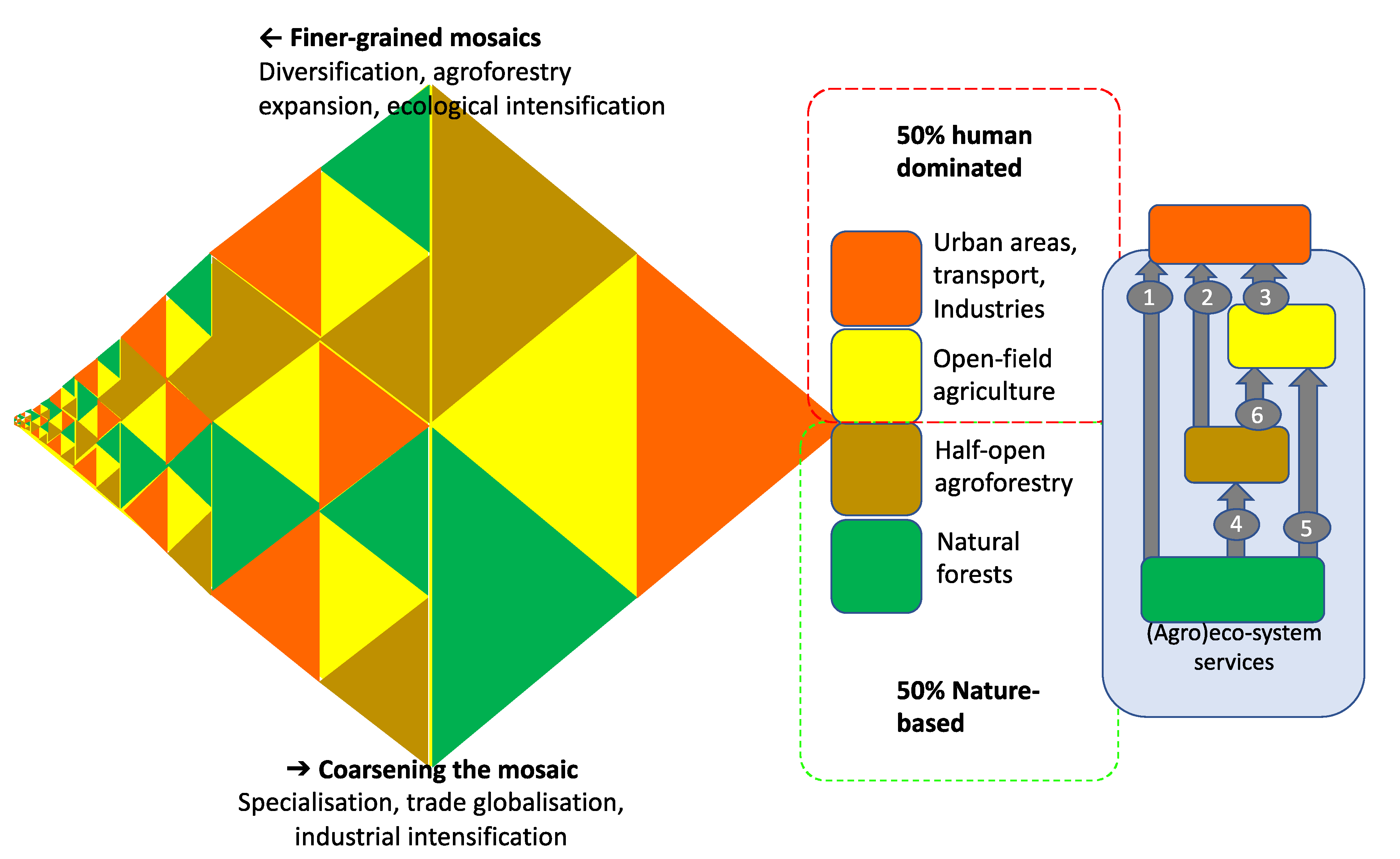
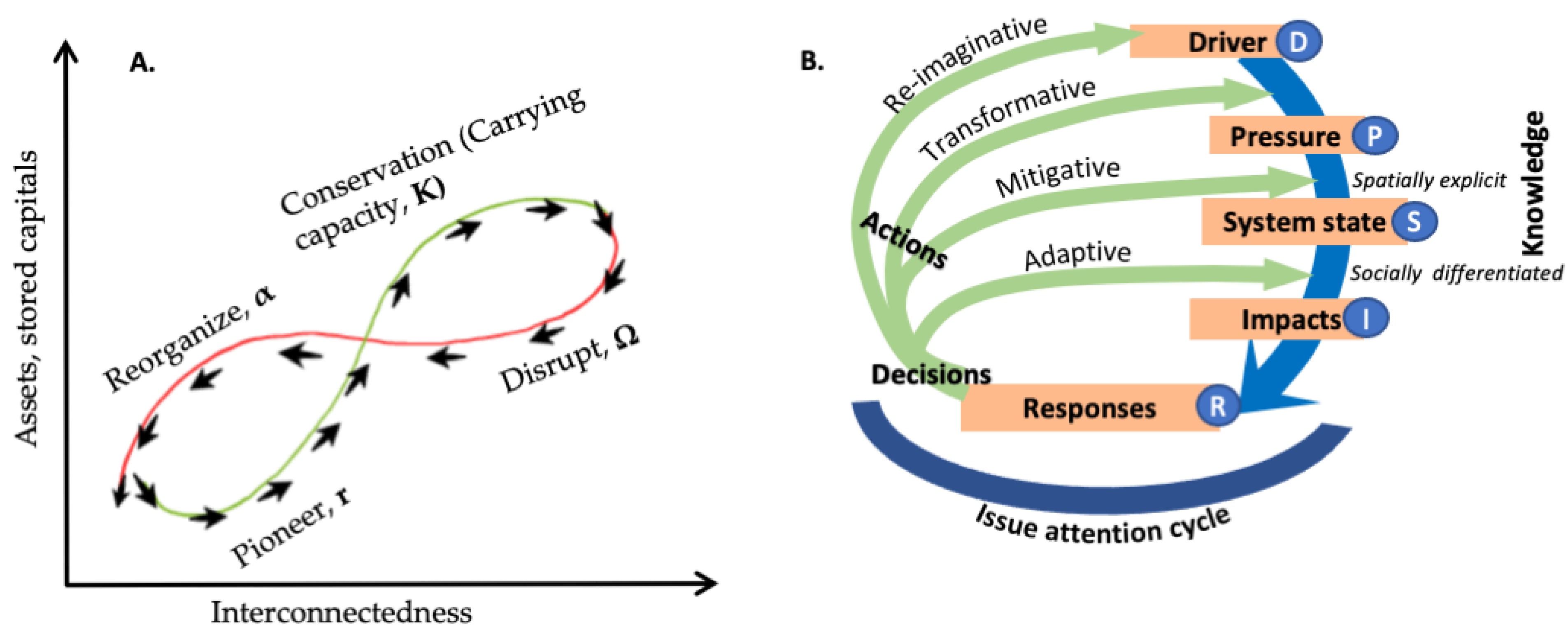
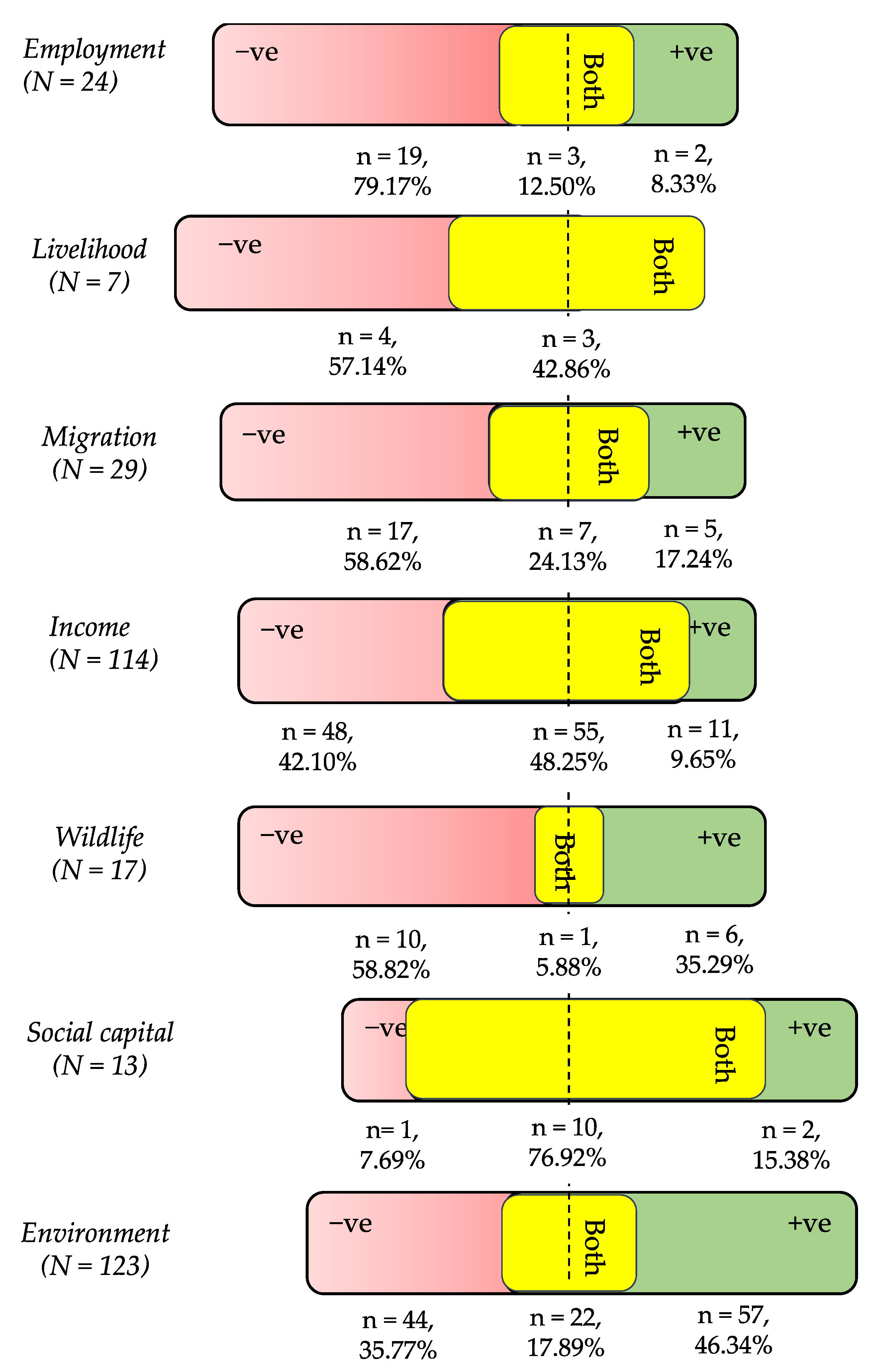
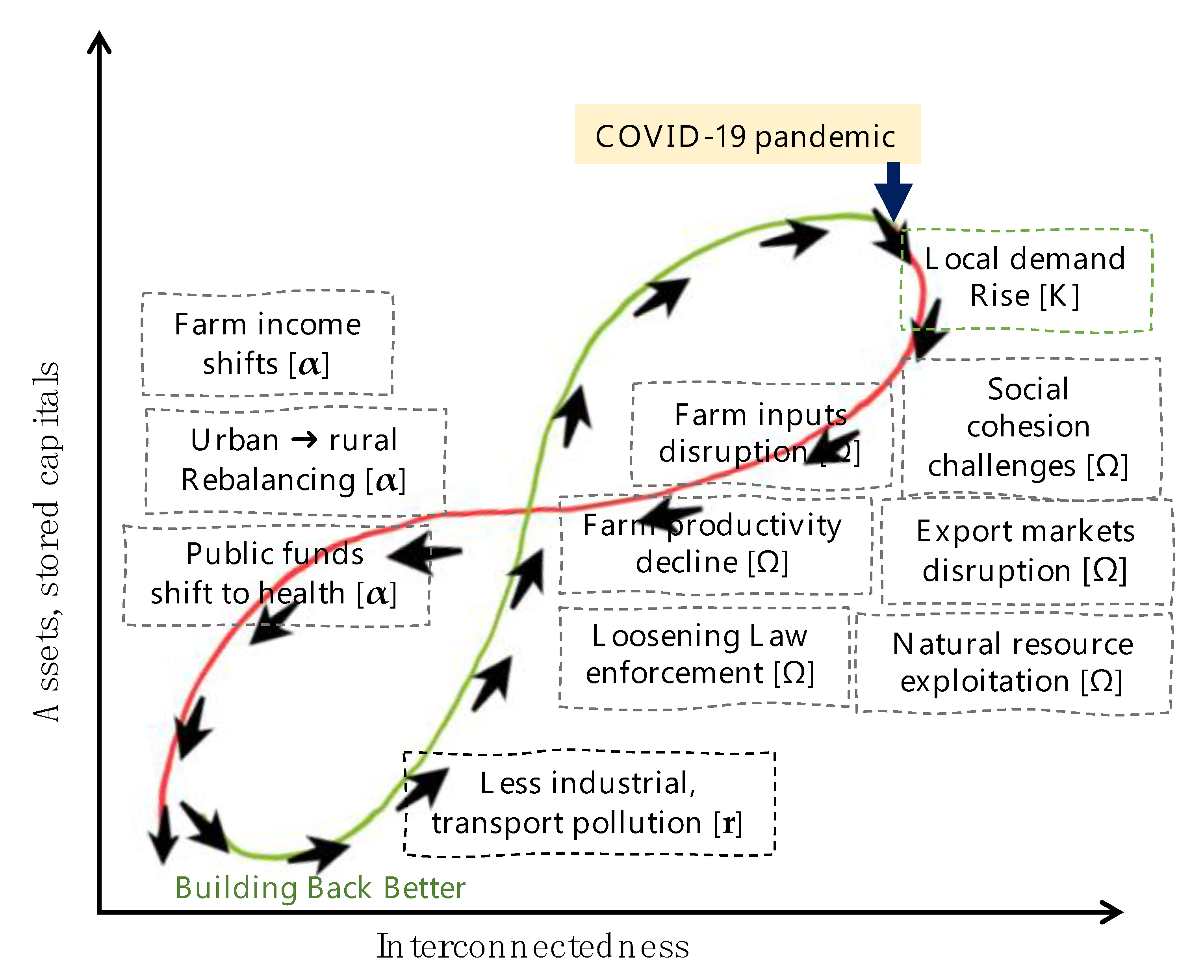
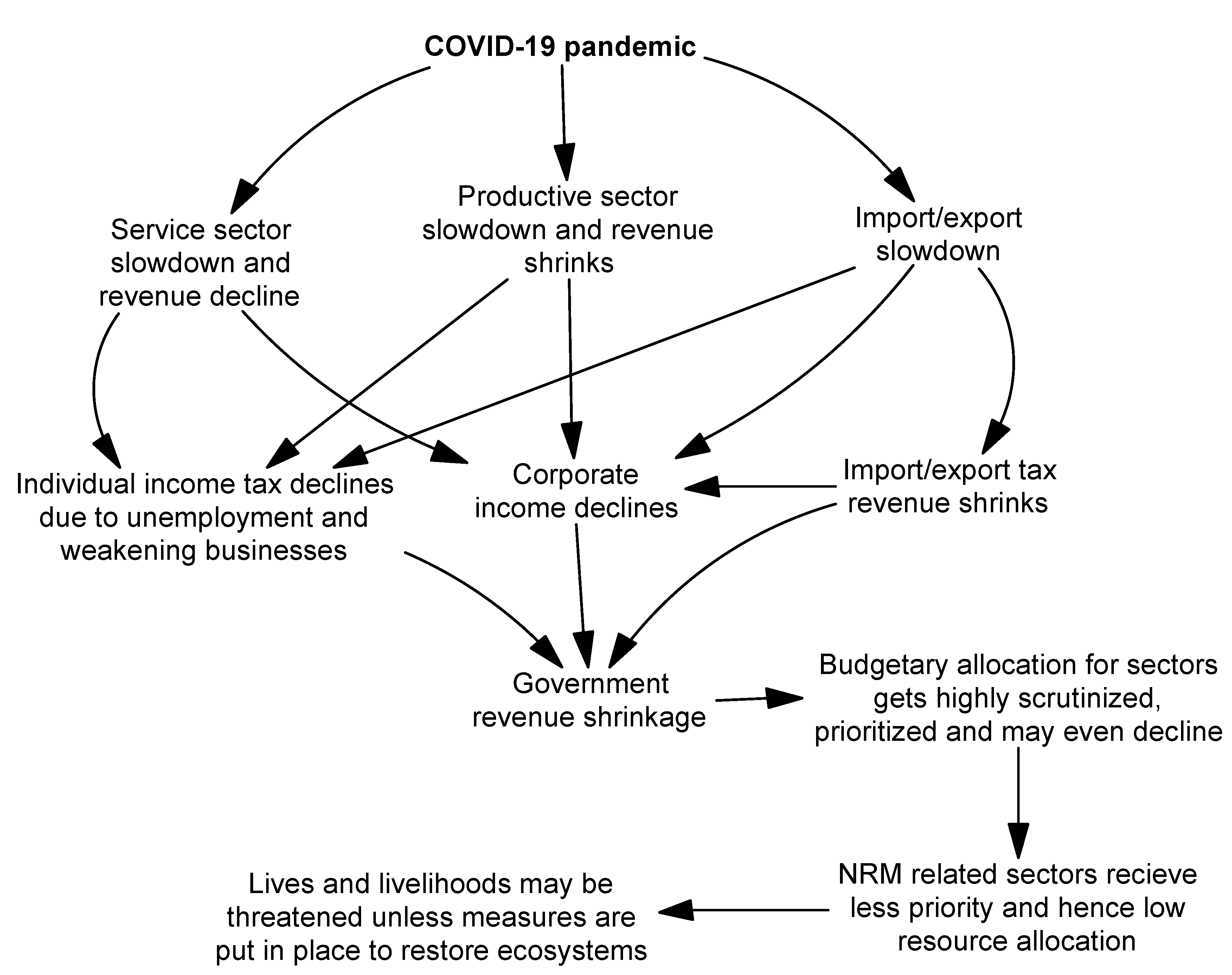
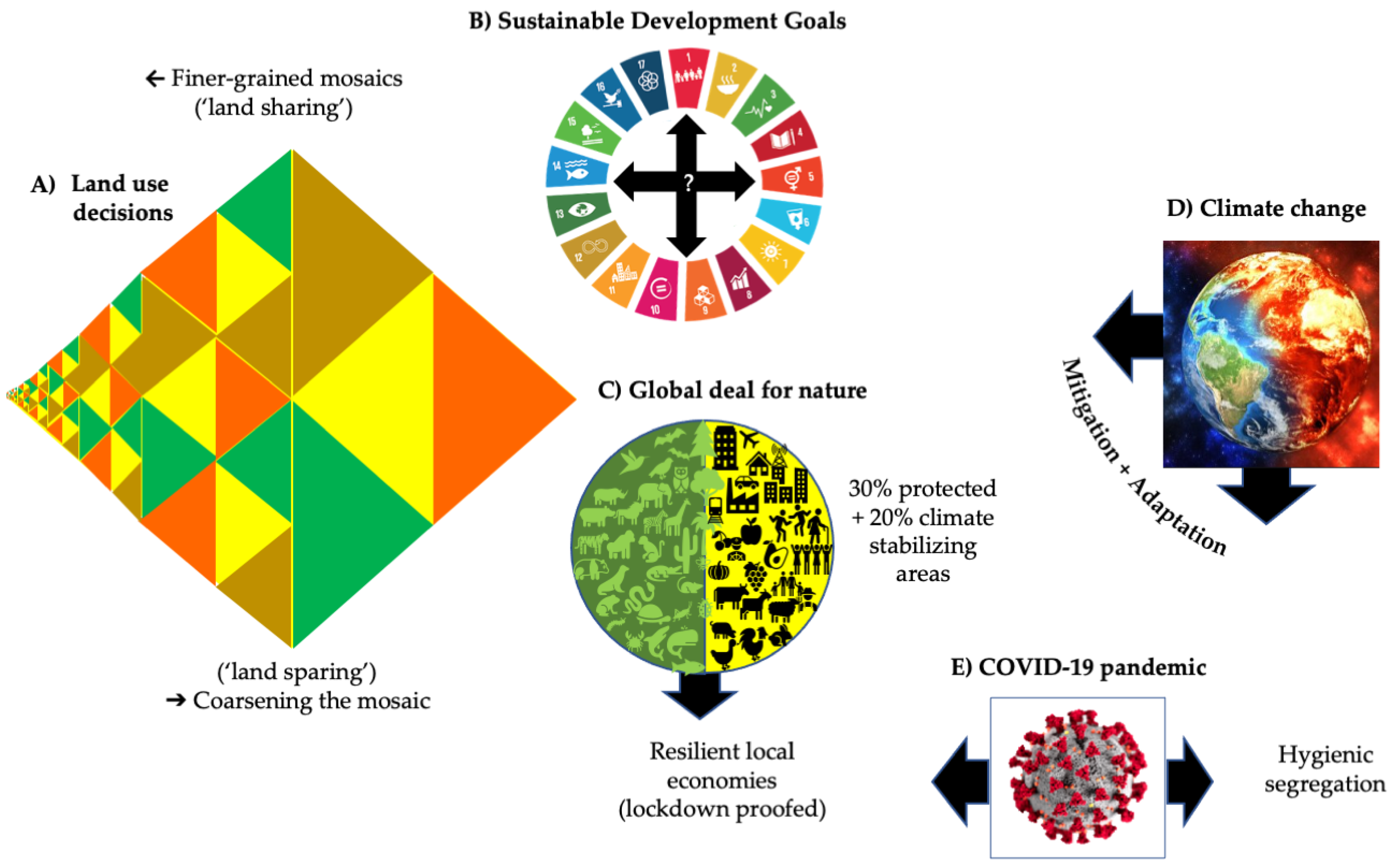
| Search Description | Search Term Combinations (Indexes: SCI-EXPANDED, SSCI, A&HCI, ESCI.) for All Years | Retrieved Documents as of 6 December 2020 | Documents Screened for Further Analysis after Qualifying the Retention Criteria |
|---|---|---|---|
| COVID-19 and its relations to environment | title: (COVID *) AND title: (environment *) | 279 | 123 |
| COVID-19 and its relations to wildlife | title: (COVID *) AND title: (wildlife *) | 18 | 17 |
| COVID-19 and its relations to income | title: (COVID *) AND title: (income *) | 118 | 114 |
| COVID-19 and its relations to migration | title: (COVID *) AND title: (‘migration’) | 36 | 29 |
| COVID-19 and its relations to livelihood | title: (COVID *) AND title: (livelihood *) | 9 | 7 |
| COVID-19 and its relations to employment | title: (COVID *) AND title: (employment *) | 29 | 24 |
| COVID-19 and its relations to social capital | title: (COVID *) AND title: (social capital *) | 13 | 13 |
| Total | 502 | 327 |
| Types of Responses | Main Drivers of Response in Relation to COVID-19 | Consequences on Agroecosystems |
|---|---|---|
| Full family relocation (urban to rural; rural to rural) | Unemployment; income shortage | Increasing the need for food, feed, water, and other basic needs in the agroecosystems |
| Partial family relocation (urban to rural; rural to rural) | Either the husband or wife is left in urban areas with others relocating to rural areas | Same effect as above |
| Food and other consumable support (rural to urban) | Rural families send food and other supplies to their relatives in urban areas | Same effect as above |
| Unemployed members of family relocation (urban to rural; rural to rural) | Loss of jobs by youth members of the family and relocating to rural homes | Increased rate of forest clearance, poaching, charcoal production |
| Changing livelihood means | Loss of jobs in rural economic sectors e.g., tourism and hospitality, manufacturing, export sector slowdowns, etc. [35] | Same as above |
| Needs Categories | Sources from Agroecosystems/Socioecological Systems | How COVID-19 May Affect the Supply Sources |
|---|---|---|
| Food | Crops | Due to disruptions in inputs delivery and crop calendar, crop production is likely to be affected [39]. The need for additional food for family members who lost their job in urban and service sectors increases. |
| Livestock | Due to disruptions in livestock market and medication particularly vaccinations implying decline in productivity of livestock and in the medium-term decline in herd sizes. | |
| Wild foods (fish, bushmeat, honey, tree foods) | Increased extraction for wild foods due to market supply of food crops disruptions. People engage in hunting and wild food collection increasing pressure [40,41,42]. | |
| Energy | Electricity | Less income for households [29] means declining affordability of electricity. |
| Forest wood | Extraction of wood from forests for energy may increase due to the low affordability of electricity. | |
| On-farm trees | Use of on-farm trees for cooking and heating increases [30]. Farmers may even sell wood for energy to earn income. | |
| Solar power | Access to solar panels and other accessories declines due to international trade disruptions [43]. | |
| Water | Freshwaters (stream sand rivers) | There is a rising waste management problem, especially for face masks and gloves produced, used and disposed ending up in streams and rivers polluting water sources [44,45,46]. |
| Health | Local health facilities | Access to local health services declines due to shrinking income and people revert to traditional and herbal medicines. People are also scared to go to health services and more relying on traditional sources of medicines mostly from the agroecosystems. |
| Herbal/traditional medicines | Exploitation of plant-based traditional medicines increases as affordability of health facilities declines. | |
| Income | Annual crops | Sales of crop harvests disrupted [29,47] and those producing fragile crops lose significantly. Input supply disruptions also mean a likely decline in productivity. This affects the farmers’ income [48]. |
| Tree commodities (coffee, coconut, oil palm, etc.) | Tree products marketing reduced due to export disruptions and market slowdown [38]; input supplies for tree crop farm management disrupted implying poor tree farms management; labor shortage as laborers were returning to their families in remote or rural areas. | |
| Shrinking employment opportunities | Activity slowdowns or closures led to job losses by those working as casuals and in the service sector workers in urban and rural areas [47,49,50]. |
| Sector | Immediate Issues/Impacts | Likely Consequences |
|---|---|---|
| Agriculture | Decreased labor supply (even if it may be temporary) | Poor agricultural productivity [51,52,53] |
| Limits farming input supplies | Total production loss or low agricultural production and hence poverty [53,54,55,56] | |
| Increased costs of agricultural inputs | Reduced benefits for farming communities [45,56] | |
| Weakens innovation through research for development | Future of agriculture is uncertain unless innovation picks up | |
| Less adaptative crop varieties are used for farming | No or very low productivity with likely effect of food insecurity [29,56] | |
| Less disease and pest resistant crops varieties used | Poor agricultural productivity and likely food insecurity [45] | |
| Poor soil management | Degradation of agricultural lands and hence low productivity [52,57] | |
| Forestry | Illegal forestland encroachment expansion [30] | Degraded forests and hence low ecosystem services generation e.g., hydrological and habitat values |
| Any forest inventories may not happen | Except delays in forest data though not an immediate worry | |
| Fishery | Unpredictable fishing livelihoods | Future fishing dependent livelihoods may be threatened [39] |
| Wildlife | Poaching and bushmeat hunting expansion [48] | Wildlife resources may decline |
| Exposure of protected areas and conservation areas to intruders [39,47] | Conservation areas could be exposed to land grabbing and wildlife could be endangered | |
| Water resources | Pollution of water resources may be a challenge [42,43,44] | Community health impact may become a significant concern |
| Areas of Action | Potential Measures for Building Better Futures |
|---|---|
| Landscape (jurisdictional) level | Establishing natural resource-based safety-nets through better landscape management, which includes averting ecosystem degradation, ecosystem restoration, waste and pollution management |
| Enriching landscape-level practice portfolios with climate resilient production systems such as agroforestry | |
| Strengthening enforcement of rules and regulation for sustainable use and management of agroecosystems | |
| Boosting natural resources-based enterprises with strong local demand | |
| Designing cross-jurisdictional resource management strategies to reduce illegal exploitation during fragile moments | |
| Investing in postharvest infrastructures (e.g., cold-rooms, storage units, transportation, etc.) to reduce postharvest loses | |
| Household level | Embracing diversified and climate smart production systems that depend less on external inputs. For example, perennial crops are less likely to be affected as compared to annual crops which are season specific |
| Proper land use plans that promote multifunctional production systems could help in ensuring the sustainable supply of basic needs i.e., food, feed, water, and energy | |
| Embracing climate smart microfarming options in land scarce environments such as urban and periurban areas e.g., fruit trees and perennial vegetables in homesteads |
Publisher’s Note: MDPI stays neutral with regard to jurisdictional claims in published maps and institutional affiliations. |
© 2021 by the authors. Licensee MDPI, Basel, Switzerland. This article is an open access article distributed under the terms and conditions of the Creative Commons Attribution (CC BY) license (http://creativecommons.org/licenses/by/4.0/).
Share and Cite
Duguma, L.A.; van Noordwijk, M.; Minang, P.A.; Muthee, K. COVID-19 Pandemic and Agroecosystem Resilience: Early Insights for Building Better Futures. Sustainability 2021, 13, 1278. https://doi.org/10.3390/su13031278
Duguma LA, van Noordwijk M, Minang PA, Muthee K. COVID-19 Pandemic and Agroecosystem Resilience: Early Insights for Building Better Futures. Sustainability. 2021; 13(3):1278. https://doi.org/10.3390/su13031278
Chicago/Turabian StyleDuguma, Lalisa A., Meine van Noordwijk, Peter A. Minang, and Kennedy Muthee. 2021. "COVID-19 Pandemic and Agroecosystem Resilience: Early Insights for Building Better Futures" Sustainability 13, no. 3: 1278. https://doi.org/10.3390/su13031278
APA StyleDuguma, L. A., van Noordwijk, M., Minang, P. A., & Muthee, K. (2021). COVID-19 Pandemic and Agroecosystem Resilience: Early Insights for Building Better Futures. Sustainability, 13(3), 1278. https://doi.org/10.3390/su13031278








